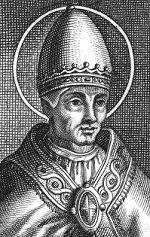 When Theodoric learned that his victim, Pope St. John, had died in prison
he took measures to ensure that the next pope would be friendly. He put
forward as his candidate Felix of Samnium, a priest of the Roman Church.
The King's wishes were respected, and Felix, a man of excellent character
anyway, was elected.
When Theodoric learned that his victim, Pope St. John, had died in prison
he took measures to ensure that the next pope would be friendly. He put
forward as his candidate Felix of Samnium, a priest of the Roman Church.
The King's wishes were respected, and Felix, a man of excellent character
anyway, was elected.
In spite of being a royal nominee Felix proved to be a good pope. He used
his favor with the Gothic Court to help the Church. Theodoric did not long
survive his illustrious victim, Pope John, and died on August 30, 526. He
was succeeded by his grandson, Athalaric, a lad of ten. The real power was
the Queen Mother, Amalasuntha. This lady, Theodoric's daughter, was quite
favorable to the Church, and from her Pope Felix secured a decree, drawn up
by the noble old Cassiodorus, which reserved the trial of clerics to the
pope. Violations of this law of clerical immunity were to be punished by a
heavy fine, and any money thus obtained was to go to the poor. The Pope
also received two temples in the Roman forum, that of Romulus, and that of
the Sacred City. These he made over into the Church of Sts. Cosmas and
Damian. The church still stands and to this day may be seen there mosaics
made by order of Pope Felix.
In Gaul there had arisen a mitigated form of Pelagianism. This Semi-
Pelagianism had been taught by the ascetic John Cassian and a clever
writer, Faustus of Riez. It lingered in Gaul, and St. Caesarius of Arles
called on the Pope to help him fight this heresy. Pope Felix backed St.
Caesarius by his approval, and by trying to circulate the saint's book
against the Semi-Pelagians. He also sent a list of canons which explained
the Catholic doctrine on grace against the Semi-Pelagian heresy. These were
incorporated in the decrees of the Second Council of Orange, held in 529,
which did much to end the Semi-Pelagians.
In 529, too, an event happened of profound importance. St. Benedict founded
the Monastery of Monte Cassino, the mother abbey of those hosts of
monasteries which did so much for the Church and for civilization.
Monasticism was already a powerful force, but St. Benedict is rightly
regarded as the patriarch of Western monks. His rule--holy, wise, moderate-
-has been a ladder to perfection for millions.
By 530 Felix was gravely ill. He worried a good deal about the future, for
party feeling was running high in Rome. Pro-Goths clashed with pro-
Byzantines as the shadow of the reconquest loomed over the city. In these
disturbed circumstances Felix felt justified in taking an extraordinary
step. He chose his own successor! He gave his own pallium to the archdeacon
Boniface and solemnly proclaimed that he should be the next pope. He died
shortly after in 530.
Excerpted from "Popes
Through the Ages" by Joseph Brusher, S.J.

